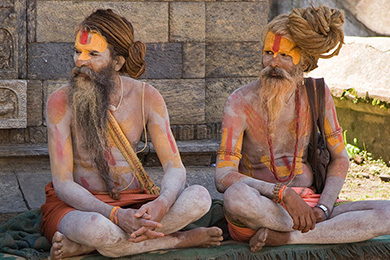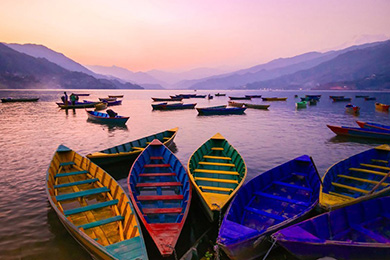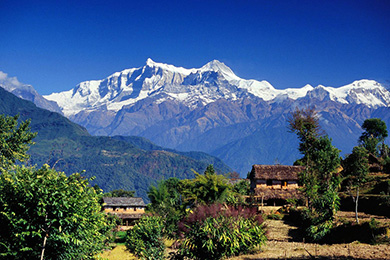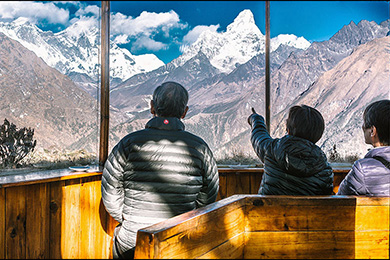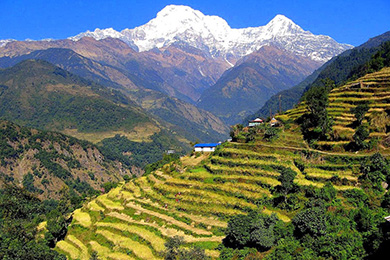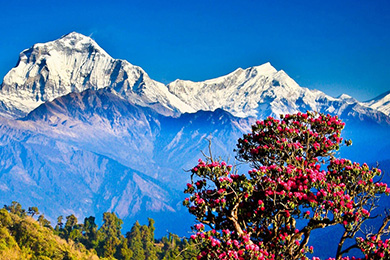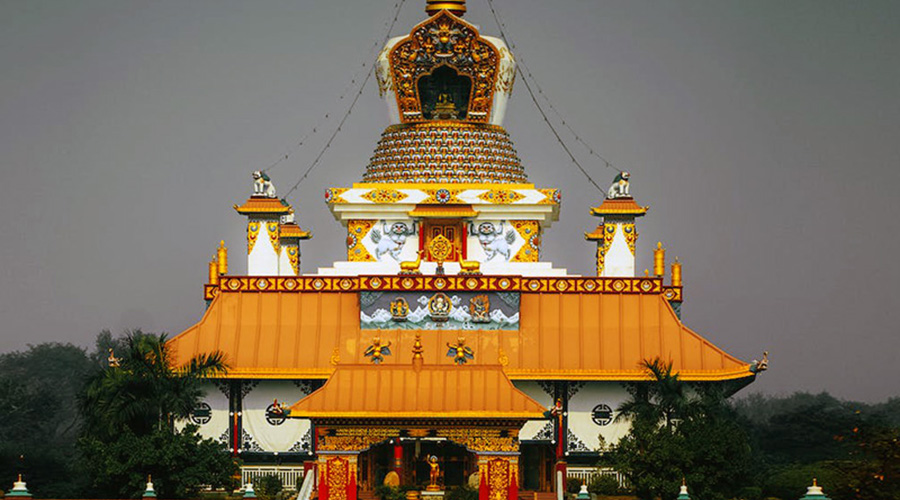
Lumbini is a significant historical and religious site located in the Rupandehi District of Nepal. It is renowned as the birthplace of Siddhartha Gautama, who later became Gautama Buddha, the founder of Buddhism. Lumbini holds immense religious and cultural importance for Buddhists worldwide and is a popular pilgrimage destination.
The area of Lumbini encompasses the sacred garden where Queen Maya Devi, the mother of Gautama Buddha, is believed to have given birth to him in 563 BCE. The birth of Buddha is considered a pivotal event in Buddhist history. The site also includes the Maya Devi Temple, which enshrines the exact spot of his birth, as well as other monasteries, stupas, and cultural structures.
Lumbini has been recognized as a UNESCO World Heritage Site since 1997. The site has undergone significant development and preservation efforts to maintain its historical and religious significance. It attracts thousands of visitors, including pilgrims, tourists, and scholars, who come to explore the birthplace of Buddha and immerse themselves in the tranquil and spiritual atmosphere.
In addition to its religious importance, Lumbini also serves as a center for Buddhist studies and research. The International Buddhist Research and Information Center, along with various monastic institutes, are located within the Lumbini Development Trust area.
Overall, Lumbini is a revered destination that holds great significance for Buddhists and offers a unique glimpse into the life and teachings of Gautama Buddha. It continues to be an important pilgrimage site and a place of contemplation and reflection for people from around the world.



Why People visit Lumbini?
People visit Lumbini for its historical and religious significance. Lumbini is a small town in Nepal and is widely regarded as the birthplace of Siddhartha Gautama, who later became known as Gautama Buddha, the founder of Buddhism. Here are some reasons why people visit Lumbini:
Birthplace of Buddha: Lumbini is the place where Siddhartha Gautama was born in the 6th century BCE. For Buddhists, it holds immense spiritual importance as the birthplace of their enlightened teacher. Many followers of Buddhism come to Lumbini to pay their respects and connect with the roots of their faith.
Sacred pilgrimage site: Lumbini is considered one of the most important pilgrimage sites for Buddhists worldwide. It is believed that Emperor Ashoka, a devout Buddhist, visited Lumbini in the 3rd century BCE and erected a commemorative pillar marking the exact birthplace of Buddha. The site is surrounded by monasteries, temples, and meditation centers, attracting pilgrims from all over the world.
Historical and archaeological significance: Lumbini has archaeological remains dating back to the time of Buddha. Excavations have revealed ancient stupas, monasteries, and other structures that provide insights into the life and times of Buddha. The Ashoka Pillar, Mayadevi Temple, and the Lumbini Museum are some of the notable attractions for history and archaeology enthusiasts.
Cultural exploration: Lumbini offers an opportunity to immerse oneself in the vibrant Buddhist culture. Visitors can witness the daily rituals, prayers, and ceremonies performed by monks and devotees. The monastic community in Lumbini is diverse, representing different Buddhist traditions from around the world. This cultural diversity makes Lumbini a unique place to experience various Buddhist practices and interact with people from different backgrounds.
Peace and tranquility: Lumbini is known for its serene and peaceful environment. The sprawling gardens and tranquil atmosphere provide a conducive setting for meditation, reflection, and inner peace. Many visitors come to Lumbini seeking spiritual rejuvenation and a break from the hustle and bustle of everyday life.
Overall, Lumbini attracts people from various walks of life, including Buddhists, scholars, history buffs, and those seeking a spiritual retreat. It offers a unique opportunity to explore the birthplace of one of the world's major religions and connect with its teachings and traditions.
Tourism in Lumbini
Tourism in Lumbini has been growing steadily over the years, driven by its historical and religious significance. The Nepalese government, along with international organizations and local stakeholders, has been working to develop and promote Lumbini as a major tourist destination. Here are some key aspects of tourism in Lumbini:
Infrastructure development: Efforts have been made to improve the infrastructure in and around Lumbini to accommodate the increasing number of tourists. This includes the construction of hotels, guesthouses, restaurants, and other facilities to cater to the needs of visitors. The Lumbini Airport has also been upgraded to facilitate easier access to the region.
UNESCO World Heritage Site: Lumbini was designated as a UNESCO World Heritage Site in 1997, recognizing its universal value as a place of historical and cultural importance. This designation has boosted the international recognition of Lumbini and attracts tourists who are interested in exploring UNESCO-listed sites.
Monasteries and Temples: Lumbini is home to numerous monasteries and temples built by Buddhist communities from around the world. These architectural marvels showcase different styles and traditions of Buddhism. Visitors can explore these monastic complexes, participate in meditation sessions, and learn about various Buddhist practices.
Maya Devi Temple: The Maya Devi Temple is a significant pilgrimage site within Lumbini. It marks the exact spot where Queen Maya Devi is believed to have given birth to Siddhartha Gautama. Pilgrims and tourists visit the temple to offer prayers, make offerings, and seek blessings.
Ashoka Pillar: The Ashoka Pillar, erected by Emperor Ashoka in the 3rd century BCE, is another prominent attraction in Lumbini. The pillar bears inscriptions confirming Lumbini as the birthplace of Buddha. It serves as a historical artifact and a symbol of Emperor Ashoka's devotion to Buddhism.
International Monastic Zone: Lumbini has an International Monastic Zone, where different countries have established their own monasteries reflecting their respective Buddhist traditions. This zone offers visitors the opportunity to explore diverse architectural styles, cultural practices, and religious teachings from various Buddhist countries.
Lumbini Museum: The Lumbini Museum provides an insight into the history, archaeology, and development of Lumbini. It houses a collection of artifacts, sculptures, and historical relics related to Buddhism and the ancient kingdom of Kapilvastu. The museum helps visitors understand the significance of Lumbini in a broader historical context.
International Buddhist Conferences: Lumbini has hosted several international Buddhist conferences and events, attracting scholars, religious leaders, and practitioners from around the world. These conferences serve as platforms for dialogue, exchange of ideas, and academic discussions related to Buddhism and its relevance in the modern world.
Tourism in Lumbini not only contributes to the local economy but also promotes cultural exchange, religious understanding, and spiritual exploration. The serene environment, rich heritage, and the opportunity to connect with Buddhism's roots make Lumbini a compelling destination for travelers interested in spirituality, history, and cultural experiences.
Monasteries and Temples in Lumbini
Lumbini is home to numerous monasteries and temples, built by different Buddhist communities from around the world. These religious structures offer visitors the opportunity to explore various Buddhist traditions, architecture, and cultural practices. Here are some notable monasteries and temples in Lumbini:
Maya Devi Temple: The Maya Devi Temple is the most important religious site in Lumbini. It is built around the sacred marker stone that indicates the exact spot where Queen Maya Devi gave birth to Siddhartha Gautama, who later became the Buddha. The temple houses a bas relief depicting the birth of Buddha and attracts a large number of pilgrims.
Mahabodhi Temple: Modeled after the Mahabodhi Temple in Bodh Gaya, India, the Mahabodhi Temple in Lumbini is a prominent pilgrimage site. It features a large gold-colored statue of the Buddha in a meditative posture. The temple complex also includes a Bodhi tree and a tranquil meditation garden.
Thai Monastery: The Thai Monastery in Lumbini is a beautiful and ornate structure designed in traditional Thai architecture. It features intricate carvings, golden decorations, and colorful paintings depicting the life of the Buddha. The monastery is known for its peaceful ambiance and hosts meditation sessions and chanting ceremonies.
Chinese Monastery: The Chinese Monastery, known as the Lumbini Dharma Swami Mahachaitya, is an imposing structure built by the Buddhist Association of China. It showcases Chinese architectural elements and houses a large prayer hall, a museum, and a library. The monastery is a significant center for Buddhist practice and cultural exchange.
Korean Monastery: The Korean Monastery, also known as the Maitreya Buddha Monastery, is an impressive structure representing Korean Buddhist architecture. It features a statue of the Maitreya Buddha, who is believed to be the future Buddha. The monastery offers meditation retreats and spiritual teachings to visitors.
Myanmar (Burmese) Temple: The Myanmar Temple in Lumbini is a replica of the Shwedagon Pagoda in Yangon, Myanmar. It is adorned with intricate golden decorations and houses a large golden stupa. The temple complex includes a prayer hall, a meditation center, and a monastery.
German Monastery: The German Monastery, known as the Tara Foundation, is a serene and beautifully designed structure. It follows Tibetan Buddhist architectural style and serves as a center for meditation, teachings, and retreats. The monastery also has a library and a garden where visitors can relax and enjoy the peaceful surroundings.
Vietnamese Monastery: The Vietnamese Monastery, also known as the Phat Quoc Tu, is a colorful and intricately decorated structure. It showcases Vietnamese Buddhist art and architecture and features statues, paintings, and carvings representing different Buddhist deities. The monastery offers meditation sessions and cultural activities.
These are just a few examples of the monasteries and temples in Lumbini. There are many more monastic complexes representing different countries and Buddhist traditions, providing visitors with a rich and diverse spiritual experience in this sacred birthplace of Buddha.
Major Things to do in Lumbini
When visiting Lumbini, there are several significant things to do that will allow you to immerse yourself in the rich history, spirituality, and cultural heritage of the birthplace of Buddha. Here are some major things to do in Lumbini:
Explore the Maya Devi Temple: Begin your journey in Lumbini by visiting the Maya Devi Temple, the focal point of the pilgrimage site. Explore the temple complex, witness the sacred marker stone indicating the birthplace of Buddha, and offer your prayers and respects.
Visit Monasteries and Temples: Lumbini is home to numerous monasteries and temples representing different Buddhist traditions from around the world. Take the time to explore these architectural marvels, experience different cultural practices, and engage in meditation or spiritual teachings offered by the monastic communities.
Walk along the Sacred Garden: The Sacred Garden is a peaceful and beautifully landscaped area surrounding the Maya Devi Temple. Take a leisurely stroll through the garden, enjoying the serene atmosphere, and reflect on the profound teachings of Buddhism.
Meditate and Practice Mindfulness: Lumbini offers an ideal environment for meditation and mindfulness practice. Find a quiet spot in the gardens or monasteries, sit in silence, and engage in self-reflection or meditation. Many monasteries also offer meditation retreats and guided sessions for visitors.
Visit the Ashoka Pillar: Pay a visit to the Ashoka Pillar, an ancient monument erected by Emperor Ashoka in the 3rd century BCE. The pillar bears inscriptions confirming Lumbini as the birthplace of Buddha and provides a glimpse into the historical significance of the site.
Explore the Lumbini Museum: Gain a deeper understanding of Lumbini's history and archaeology by visiting the Lumbini Museum. The museum showcases artifacts, sculptures, and historical relics related to Buddhism and the ancient Kapilvastu kingdom, providing valuable insights into the life and times of Buddha.
Attend Buddhist Ceremonies and Events: Lumbini hosts various Buddhist ceremonies, conferences, and events throughout the year. Check the local calendar for any special events taking place during your visit and participate in rituals, teachings, or cultural performances to witness the vibrant spirit of Buddhism.
Engage with the Local Community: Interact with the local residents and the monastic community in Lumbini. Engage in conversations, learn about their experiences, and gain a deeper appreciation for the local culture and traditions. You may also have the opportunity to participate in community activities or volunteer work.
Enjoy Local Cuisine: Sample the local Nepalese cuisine in Lumbini. Explore nearby restaurants and cafes to savor traditional dishes such as dal bhat (rice and lentil soup), momo (dumplings), and various vegetarian options. Food can be a delightful way to immerse yourself in the local culture.
Experience the Sunset at Lumbini: Conclude your day in Lumbini by witnessing the mesmerizing sunset over the sacred birthplace. Find a serene spot in the gardens or near the temples and enjoy the tranquility and natural beauty of the surroundings as the sun sets on this significant place.
Remember to be respectful of the religious and cultural practices in Lumbini, dress modestly, and adhere to any guidelines or rules set by the monasteries and temples. Enjoy your time in Lumbini as you explore its spiritual and historical treasures.
Destination Gallery
Accusamus et iusto odio dignissimos ducimus qui blanditiis praesentium voluptatum deleniti atque corrupti quos dolores et quas molestias excepturi sint occaecati cupiditate non provident, similique sunt in culpa qui officia deserunt mollitia animi, id est laborum et dolorum fuga.





